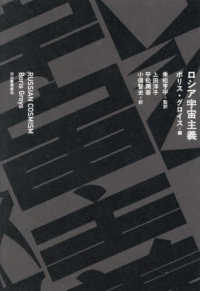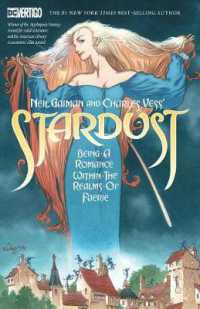- ホーム
- > 洋書
- > 英文書
- > Business / Economics
Full Description
Deryn Watson and David Tinsley The topic of the conference, integrating infonnation technology into education, is both broad and multi-facetted. In order to help focus the papers and discussion we identified 7 themes: • Current developments in society and education influencing integration; • Teachers, their roles and concerns; • Learners, their expectations of and behaviour in an integrated environment; • Developments and concerns in the curriculum; • Successes and failures in existing practice; • Organisation and management of integrated environments; • Identification of social and political influences. Each author was invited to focus on one theme, and these remained strands throughout as can be seen from the short papers and focus group reports. The first and most significant concern therefore was to be clear about our notions of integration; what do we mean and how is this relevant? Our keynote paper from Cornu clearly marked out this debate by examining the notion of integration and alerting us to the fact that as long as the use of IT is still added to the curriculum, then integration has not yet begun.
Contents
The IFIP WG 3.1 Working Conference in Barcelona. IFIP and working group 3.1. The Generalitat de Catalunya. Words of welcome. New technologies: integration into education. The computer: ally or alien? The roles and needs of mathematics teachers using IT. An action research role for teachers. Classroom ethos and the concerns of the teacher. Using evidence about teacher development to plan systematic revolution. The reality of learners' achievements with IT in the classroom. A curriculum for teachers or for learning? The case of Cabri-geometre: learning geometry in a computer based environment. Moving schema. Developing analytical competency through informatics teaching. Integration of informatics into education. Promoting interdisciplinary and intercultural intentions through the history of informatics. Implementation of computers in Malaysian Schools: problems and successes. Interpreting internal school influences on the educational integration of IT. Factors affecting the use of computers in the classroom: four case studies. Integrating IT into teaching - struggling with windmills. Effects of learners' characteristics and instructional guidance on computer assisted learning. Post experimental-phases of IT across the curriculum projects: the Spanish view. Social and political influences on the integration of informatics into Japanese education. The failure of the education system to attract girls to formal informatics studies. Learners and their expectations for an integrated informatics environment. Societal and organisational influences on integration: what about networking? Short Papers. The teacher's role in a new problem-centred interdisciplinary approach. Teacher training, problems in mathematics teaching and the use of software tools. School environments and students' opinions on informatics. Animation microworlds for children as developers. How to develop discoveries. Integration of portable computers into Australian classrooms: issues and outcomes. Developing an open learning environment with communication technologies. The British approach to the integration of IT into the curriculum. Focus groups report. Addresses of contributors and programme committee. Index of contributors. Keyword index.








